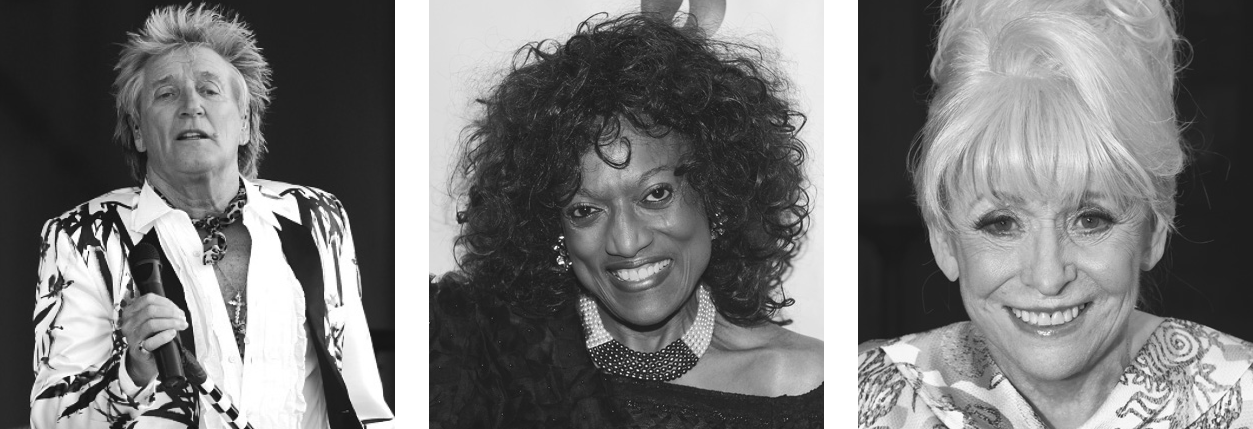
Q1
Can you put these people into chronological order?

CLUES
- Forget about their actual birth dates.
- You might reasonably describe them all as showbusiness royalty.
Q2
Madiba might share common beginnings with a defunct checkpoint in Jerusalem, a computer pattern relating to chaos theory and a British master of spin. Who or what are they all?
CLUES
- Madiba is a nickname for a very eminent world leader of recent history.
- Master of spin’ is not a reference to a cricketer.
A1
Each of the stars’ surnames is also the name of one of the royal houses of England, so it is those whose chronological order we’re after.
They are Rod Stewart (i.e. Stuart), b. 1945; the operatic soprano Jessye Norman, born in Augusta, Georgia, in 1945; and Dame Barbara Windsor, née Deeks, b.1937, sex symbol of the Carry On movies in the 1960s and 1970s, latterly a key member of the cast of EastEnders as the formidable matriarch and landlady Peggy Mitchell.
So the correct order is Norman (1066–1154), Stuart (1603–1714), Windsor (1917–), 17 July 1917 being the date when George V promulgated the change of name from Saxe-Coburg-Gotha to Windsor.
Somebody who knows their Scottish history, however, might give a slightly different, and better-informed, answer, to the effect that the Stewarts were the ruling family of Scotland before the Stuarts took over in England (having changed the spelling of their name), from the accession of Robert II in 1371 to James VI’s move to London in 1603. Stewart is, in any case, the etymologically correct spelling, reflecting the family’s descent from Walter the Steward.
A2
These are all names beginning with the letters Mandel – thus their ‘common beginnings’.
Madiba is the Xhosa name now often applied reverentially to the Nobel Peace Prize-winning South African head of state Nelson Mandela (1918–2013).
The checkpoint is the Mandelbaum Gate, which between 1948 and 1967 was the crossing-point between the Israeli and Jordanian halves of divided Jerusalem.
A computer-generated, infinitely repeating pattern, which relates to the conditions in which chaos theory operates, is known as a Mandelbrot set.
The political figure, architect of the New Labour project in the 1990s and one of the earliest figures in the UK to earn the title of ‘spin doctor’ (as well as the sobriquet ‘the Prince of Darkness’ among his enemies) is Peter Mandelson, Baron Mandelson (b.1953). His maternal grandfather was the leading 1940s Labour politician and cabinet minister Herbert Morrison.
Q3
Washington – Washington – Buffalo – Dallas. What’s the significance of this sequence?
CLUES
- These are the only four in this sequence to date.
- It’s not a sporting sequence.
Q4
An ancient stone, who has several daughters, is certainly the oldest; another was a notorious London character in Tudor times; and a third went back to Edinburgh Castle in the nineteenth century, though she dates from long before that. Who are they?
CLUES
- They are all referred to as female, though in fact two of them are inanimate objects.
- The ancient stone is in the far north of England.
A3
These are the locations, in chronological order, of the assassinations of the four US presidents who have been killed in office.
Abraham Lincoln was shot by John Wilkes Booth at Ford’s Theatre in Washington, DC in 1865.
James Garfield was shot by Charles J. Guiteau at the Baltimore & Potomac Railroad Station in Washington in 1881 – he died 79 days later of sepsis and pneumonia resulting from his wounds.
William McKinley was shot by the reclusive Polish-American anarchist Leon Czolgosz as he visited the Pan-American Exposition in Buffalo, NY, in September 1901.
And, of course, John F. Kennedy was shot by Lee Harvey Oswald in Dealey Plaza in Dallas in November 1963.
A4
Megs.
‘Long Meg and her daughters’, the third-largest stone circle in Britain, are prehistoric standing stones at Little Salkeld near Penrith in Cumbria. Meg is a 15-foot sandstone pillar, and her daughters are smaller boulders, 69 or so in number. Local legend has it that every time you count them, you get a different number. If you count them twice and the
number is the same, they will come to life as witches. The stones are the subject of a sonnet by Wordsworth from about 1821 and a terrific poem by Andrew Young, 1936.
Long Meg of Westminster was a legendary figure dating from the London of the reign of Henry VIII. Little is known about her for certain, but she may have been an innkeeper or brothel-keeper; she became notorious for her fiery character and outrageous exploits, celebrated and embellished in ballads and chap-books for many years after her death.
Mons Meg is a huge fifteenth-century cannon made at Mons in what is now Belgium and given to James II of Scotland, who used it in 1455 against the Douglases at Threave Castle. It was used in further sieges until the sixteenth century and kept at Edinburgh Castle until 1754 when it was taken to the Tower of London. It was returned to Edinburgh in 1829 at Sir Walter Scott’s request. (It has nothing to do with the First World War Battle of Mons.)
Q5
Why might an art gallery in Liverpool, a colourful housing development in Newcastle, an avuncular popularizer of horticulture and a friend to the Flytes all display a competitive streak?
CLUES
- A bit of teamwork could come in handy here.
- The popularizer of horticulture is no longer with us, but was known at one time by more or less the whole British nation.
Q6
Why are a royal mountain, some muddy water, a trading point and two queens, one of them specific, among the greatest glories of a settlement that stretches from sea to sea?
CLUES
- The word ‘settlement’ is used for a reason, though it is deliberately misleading.
- The specific queen is Victoria.
A5
Their names all suggest athletic competition and they might therefore all be encountered at an athletics tournament or the Olympic Games.
The Walker Art Gallery, a Liverpool landmark and home to one of the UK’s most important art collections, opened in 1877.
The colourful and award-winning Byker Wall development was designed by Ralph Erskine to replace cleared slums in the east end of Newcastle in the 1970s.
The popularizer of horticulture is Percy Thrower (1913–88), gardener, writer and broadcaster, loved by generations of TV viewers in the UK for his gentle presentation style.
The protagonist of Brideshead Revisited, Evelyn Waugh’s novel published in 1945, is Charles Ryder. He befriends the wealthy Flyte family after becoming close to the wayward Sebastian as a student at Oxford. In the famous TV adaptation of the 1980s he was portrayed by Jeremy Irons.
A6
The ‘settlement’ is Canada, whose name derives from an Iroquoian word for a settlement, and whose national motto is a mari usque ad mari (‘from sea to sea’) – and these are references to five of its major cities.
The royal mountain is Montreal (Quebec), named for the hill in the centre of the city. Winnipeg (Manitoba) means the place of muddy water, a Western Cree name first applied to Lake Winnipeg. The capital city Ottawa takes its name from an Algonquin word meaning trade, first applied to the River Ottawa on which it stands. Regina (Saskatchewan) is Latin for a queen, and Victoria (British Columbia) is the specific queen.
Q7
What connects a pair of atmospheric radiation bands, a towering art-deco masterpiece, and a court procedure offering resolution when it’s six of one and half-a-dozen of the other?
CLUES
- You will be misled by ‘court procedure’ if you assume it’s to do with the law.
- If we said ‘belts’ instead of ‘bands’, that might help you.
Q8
How do you know you can count on Danny’s gang, Lumet’s jurors and Thurber’s clocks?
CLUES
- In RBQ-land, the expression ‘to count on’ is usually a signal that numbers are involved.
- Danny’s gang is a criminal gang.
A7
This is about the achievements of three people called Van Allen or Van Alen.
The Van Allen Belts of charged particles around the Earth were described by the American physicist James Van Allen (1914–2006). He became interested in the detection of cosmic rays and helped to develop the USA’s first satellite, Explorer I, in 1958, with his cosmic ray detector aboard. Satellite observations showed that the Earth’s magnetic field traps high speed charged particles in two belt-shaped zones.
New York’s art-deco Chrysler Building, completed in 1929, was the work of the architect William Van Alen (1883–1954). Walter Chrysler simply told Van Alen: ‘Make it higher than the Eiffel Tower.’ He did: it measured 1,046 feet including the surmounting spire; but its supremacy as the world’s tallest structure only lasted a couple of years, until the completion of the Empire State Building in 1931.
‘Court procedure’ is an allusion to the tennis tie-breaker, devised by James Van Alen (1902–91), which comes into play when the score in a set stands at six games all. Van Alen was also the founder of the International Tennis Hall of Fame, the world’s largest tennis museum, at Newport, Rhode Island.
A8
This is a numerical sequence.
Danny (Ocean)’s gang in the 1960 film starring Frank Sinatra, Peter Lawford, Dean Martin, Joey Bishop and Sammy Davis Jr, and in the Steven Soderbergh remake of 2001, is Ocean’s Eleven.
Sidney Lumet directed Henry Fonda and 11 others in the claustrophobic courtroom classic Twelve Angry Men (1957).
James Thurber wrote the fantasy story The Thirteen Clocks (1950).
Q9
Where you would go to earn your crust; what you would use to keep you dry on the way; what you would ask someone who claimed to recognize you; what you would call him if he insulted you; what you would do if everyone applauded; and what you might wear if you made a huge success of all of this. Who might you be, if all of this applied to you?
CLUES
- Take one of these phrases and give the first answer that comes into your head: you may see the theme quickly.
- You might be someone known only by their first name.
Q10
Why might the author of The Periodic Table, an anti-apartheid campaigner and Pam Ewing all deserve priority treatment?
CLUES
- The Periodic Table is a creative work, which is why it’s italicized: we don’t mean the compiler of the periodic table of elements.
- The anti-apartheid campaigner is a woman.
A9
You might be Rihanna – because these phrases all suggest titles of some of her hit songs between 2007 and 2016.
To earn your crust you would go to ‘Work’; to stay dry you would use an ‘Umbrella’; if someone claimed to recognize you, you might ask ‘What’s My Name?’, and if they insulted you, you would call them a ‘Rude Boy’. After being applauded you would ‘Take a Bow’ and if you made a huge success of it all you would wear ‘Diamonds’.
A10
Because they have names which imply that they are ‘number one’.
Primo Levi (1919–87) was the author of The Periodic Table, not a chemistry textbook (though Levi was a chemist) but a collection of autobiographical short stories that amount to a restrained and moving account of survival in the Nazi concentration camps.
Ruth First (1925–82) was an early member of the African National Congress. In 1949 she married lawyer and labour organizer Joe Slovo, another white member of the ANC; both were tried and acquitted at the Treason Trial of 1956. Their friends included leaders such as Walter Sisulu and Nelson Mandela. In 1982 she was assassinated while living in exile.
Victoria Principal (b.1950) played Pamela Ewing in Dallas. A central character through the show’s entire run, Pam was the wife of J. R. Ewing’s younger brother Bobby (Patrick Duffy) and sister of rival oil tycoon Cliff Barnes (Ken Kercheval).